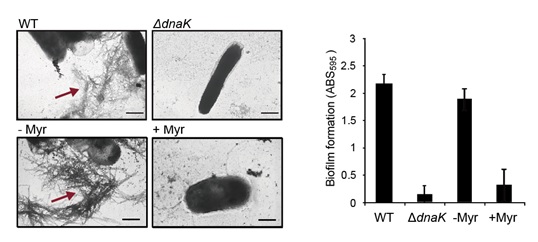
Ken-ichi Arita-Morioka, Kunitoshi Yamanaka, Yoshimitsu Mizunoe, Teru Ogura, and Shinya Sugimoto (2015) Novel strategy for biofilm inhibition by using small molecules targeting molecular chaperone DnaK. Antimicrob. Agents Chemother. 59: 633-641.
Biofilms are complex communities of microorganisms that attach to surfaces and are embedded in a self-produced extracellular matrix. Since these cells acquire increased tolerance against antimicrobial agents and host immune systems, biofilm-associated infectious diseases tend to become chronic. We show here that the molecular chaperone DnaK is important for biofilm formation and that chemical inhibition of DnaK cellular functions is effective in preventing biofilm development (Figure; Right panel). Genetic, microbial, and microscopic analyses revealed that deletion of the dnaK gene markedly reduced the production of the extracellular functional amyloid curli (Figure; Left panel), which contributes to the robustness of Escherichia coli biofilms. We tested the ability of DnaK inhibitors myricetin (Myr), telmisartan, pancuronium bromide, and zafirlukast to prevent biofilm formation of E. coli. Only Myr, a flavonol widely distributed in plants, inhibited biofilm formation in a concentration-dependent manner (50% inhibitory concentration [IC50]= 46.2 μM); however, it did not affect growth. Transmission electron microscopy demonstrated that Myr inhibited the production of curli (Figure; Left panel). Phenotypic analyses of thermosensitivity, cell division, intracellular level of RNA polymerase sigma factor RpoH, and vulnerability to vancomycin revealed that Myr altered the phenotype of E. coli wild-type cells to make them resemble those of the isogenic dnaK deletion mutant, indicating that Myr inhibits cellular functions of DnaK. These findings provide insights into the significance of DnaK in curli-dependent biofilm formation and indicate that DnaK is an ideal target for antibiofilm drugs.

Figure. Importance of DnaK in curli production and biofilm formation.
Left panel: ΔdnaK or the addition of a DnaK inhibitor, Myr, shows the reduction of curli (red arrow) production. Scale bar, 500 nm. Right panel: Decrease in curli production causes reduction of biofilm formation.